|
Late-War Bf 109G/K in Detail
Part One
Cowl Bulges for DB 605AS series & D Powered Bf 109s
Photographs by Evergreen Education Facility (via Bob Rinder)
Descriptions by Brett Green
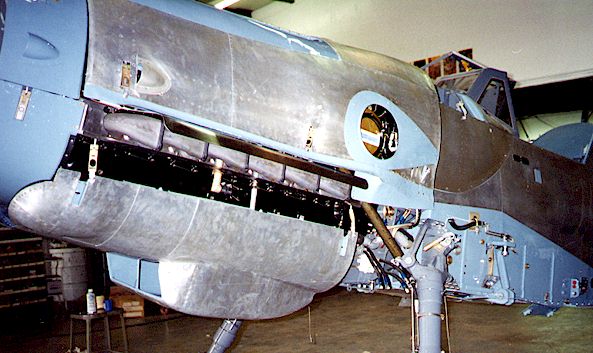
|
Messerschmitt
Bf 109G-10
under restoration at Ft. Collins for the Evergreen Education Facility
Photo: Copyright © 1998 Evergreen Education Facility; Robert Rinder and Mike Conner |
Part One of "Messerschmitt Bf 109G/K in
Detail" focuses on the contentious area of the conformal bulge.
The so-called "bulged" cowling was required
to accommodate the larger supercharger, engine bearers, struts and pipes associated with
the DB605AS/ASM/ASC and DB605D series of engines.
Bob Rinder and Mike Conner have kindly allowed
HyperScale to reproduce these excellent photographs to provide a unique insight into this
difficult subject. We are also grateful to John Beaman and Dr Charles Metz for their
comments and assistance.
Part Two illustrates
this interesting feature with six additional photographs courtesy of David Lake.
The "Captain Michael King Smith Evergreen Education Centre" in Oregon USA
commissioned the restoration of this interesting aircraft. It can be traced as a Bf
109G-14 that was rebuilt as a Bf 109G-10 with the new werknummer 610937.
This werknummer is consistent with a Bf 109G-10 equipped with a DB 605DC
engine.
For more information and photographs of the completed restoration, you can visit the
"Captain Michael King Smith Evergreen Education Centre" website by following this link.
The various styles of late-war Bf 109 "conformal" engine cowlings and
fuselage fairings have been described in detail by M. Jean-Claude Mermet in his
self-published book, "Les Messerschmitt Bf 109 G-1 a K-4 - Moteurs et
Amenagements", and also in Issue Number 13 of "Luftwaffe Verband" (January
1998). He describes a number of structural features which identify the cowl as either Type
090, Type 100 or Type 110. The latter type of cowl has a wide, shallow oil cooler intake,
a flatter bottom cowl with no "cheek blisters" and a rectangular fairing
(replacing the curved style) on the port side fuselage under the windscreen. It should
also be noted that there are some variations within these designations.
The forward fuselage of the restored aircraft is consistent with most of the features
of a Type 100 engine cowling. The style of gun troughs, the panel lines, position of
operational filler hatches, the deep oil cooler and the lower forward cheek bulges all
confirm this identity. However, there are a few mysterious omissions mentioned in the
pictorial. Although it seems that there is almost no such thing as a "standard"
Bf 109G-10, this is pretty close.
We are therefore provided with a unique opportunity to see the true profile of the
somewhat elusive "asymmetrical cowl bulge". The following ten photographs
illustrate the asymmetrical, subtle and complex nature of the late Bf 109 engine cowl.
| T
h e P i c t o r i a l . . . |
| Image 1: Firewall Looking
more like a science fiction robot, this shot of a Bf 109G-10 firewall provides a good idea
of the different shaped bulges on the Port and Starboard sides.
Note the light blue attachments to the side of the upper firewall. These are the
internal covers for the fuselage fairings behind the cowl bulges.
See how the Starboard profile (on the left side of this photo) is much flatter
than the Port side, which is both wider and curved outward. This complex curve curve
extends further out as it travels forward on the engine cowl. |
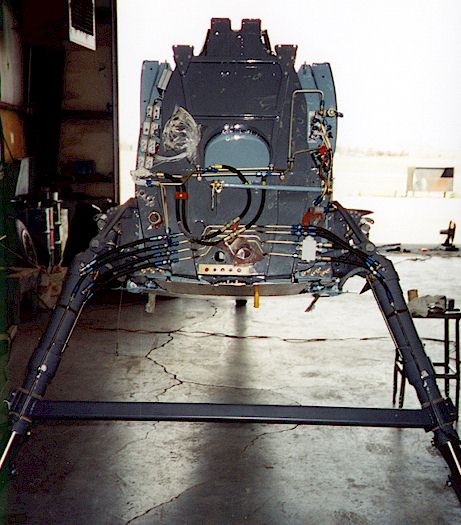 |
| Image 2: Port Side Cowl The
Port side cowl exhibits all the features expected in a Type 090 or Type 100 cowling -
namely the shorter, pressed insert and the forward vertical panel line.
The curve of the bulge is also clearly illustrated at the back edge of the cowl.
The continuation of the bulge to a position somewhere forward of the
supercharger intake hole (then tapering off until the vertical panel line) can also be
made out with the help of the reflections on the shiny metal and the backward angle of the
hole itself.
Note that the cowl halves are slightly splayed. |
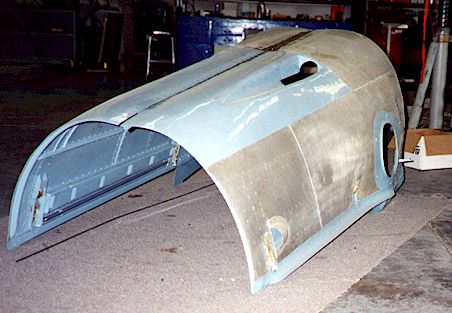 |
| Image 3: Starboard Side
Cowl Starboard cowl looks closest to a Type 100 - the access hatch to the
cold weather starter is in the higher position. On a Type 100 cowl the old access hatch
should be present immediately below the new. It was usually welded shut. However, there is
no evidence of the lower access hatch on this example.
The Starboard side cowl is clearly not nearly as curved or complex as the Port
side. It is, in fact, quite a simple fairing with an almost flat, vertical appearance at
the back of the cowl.
In summary, then, the sides are asymmetrical. |
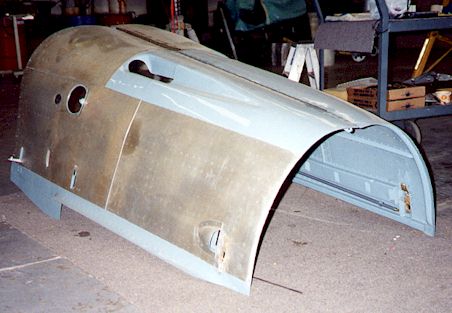 |
| Image 4: Port Cowl In
Place The Port cowl viewed from this angle demonstrates the continuation
of the bulge to near the top of the cowl, behind the port machine-gun trough. This bulge
covered the larger curved engine mount, itself required to clear the larger supercharger
of the DB605 AS and D series engines.
Also clear in this view is the deep oil cooler and the oval shaped
"bump"at the corner of the lower cowl. Note the distinct "step" at the
front and rear of the oil cooler. It is slightly odd that the oil filler cap on the cowl
ring in the lower position is missing altogether. It should be welded shut, just above the
forwardmost scoop. |
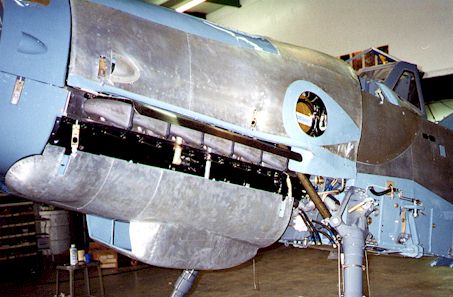 |
| Image 5: Port Side Mid
Fuselage A good shot of the fuselage fairing typical of Type 100
cowlings. This illustrates how the fairing is simply riveted to the fuselage side. Note
the small, triangular fairing similarly attached under the side of the windscreen.
Once again, reflections highlight the complex angles of the Port side cowling,
and the extreme nature of the bulge. |
 |
| Image 6: Starboard Cowl
- Side View Straight side view of the Starboard cowling. |
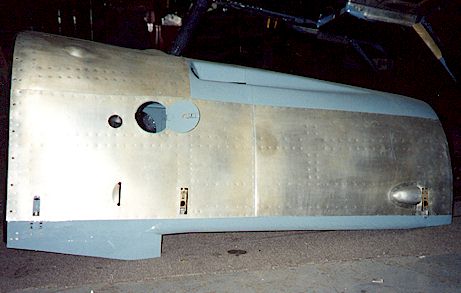 |
| Image 7: Inside of Port
Cowl and Port Wingroot Panel Note the big kink in the upper leading edge
of the Port Wingroot Panel, and the corresponding kink in the Port Side Cowling
immediately under the hole for the supercharger intake.
There is no kink on the Starboard side. |
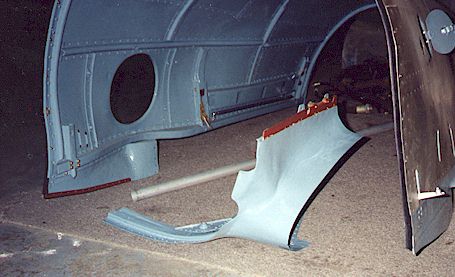 |
| Image 8: Wing Root
Fairings It is clear that the cowl intrudes significantly over the Port
Side Wingroot Panel (left side of photo). Note the difference between the Port and
Starboard sides when viewed at almost the same angle. |
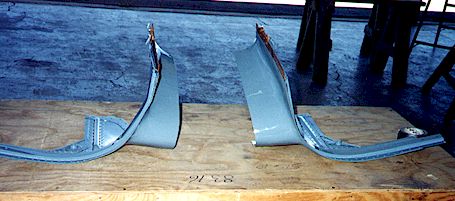 |
| Image 9: Port Side
Wingroot The Wingroot panel fits right here. The front of the panel goes
right under the supercharger, with the panel extending back to cover the gap between the
port wing and fuselage side.
Note the temporary cover on the supercharger intake.
The wing has not been installed. |
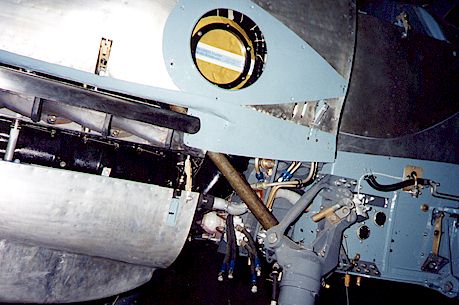 |
| Image 10: Supercharger The
wing has been installed in this photo.
And here is that big supercharger. A portion of the curved upper engine mount
may also be seen in the top of the picture. |
 |
HyperScale visitors interested in the colours, markings and origins of another late-war
Bf 109 may wish to see the "Late-War Luftwaffe Fighter
Camouflage" series on this site. Part One examines
the origins and colours of Bf 109G-6 werknummer 163824, at the Treloar Technology
Centre of the Australian War Memorial.
Mermet, Jean-Claude, "The Messerschmitt Bf 109G-10", article on pages 22-27
of Luftwaffe Verband magazine, Issue Number 13, January 1998.
Mermet, Jean-Claude, date and ISBN not quoted. "Les Messerschmitt Bf 109 G-1 a K-4
- Moteurs et Amenagements". Self Published by the Author.
Evergreen Education Facility Web
Site - historical background on Wnr 610937
Photographs Copyright © 1998 by Evergreen Education Facility; Robert Rinder and Mike Conner
Text Copyright © 1998 by Brett Green
Page created on Thursday, October 08, 1998
This page last updated on Thursday, May 09, 2002
Go to Part Two of "Late War Bf
109G/K in Detail"
Back to The Reference Library
Back to HyperScale Home Page
|
Home |
What's New |
Features |
Gallery |
Reviews |
Reference |
Forum |
Search